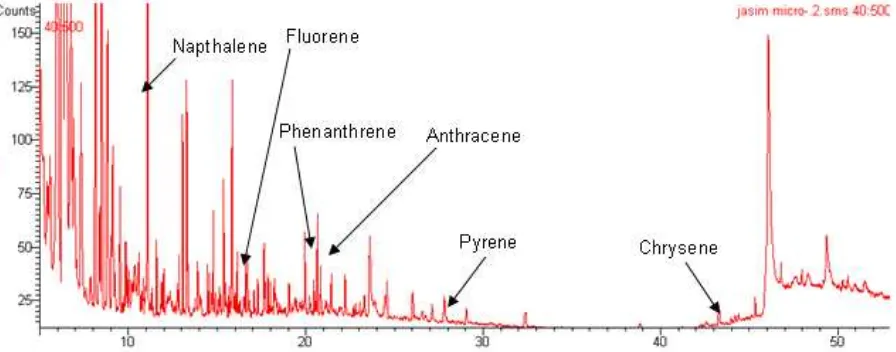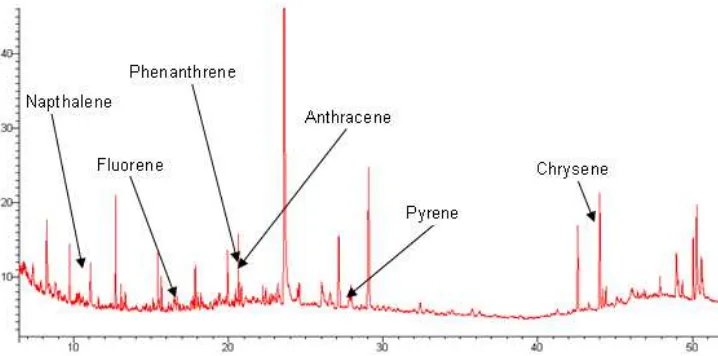Indo. J. Chem., 2008, 8 (3), 353 - 355
M. Amzad Hossain and S. M. Salehuddin
353
* Corresponding author. Tel: +88-028628913 Fax : +88-028617946; Email: dramzadh@gmail.com
IDENTIFICATION OF SOME CARCINOGENIC POLYCYCLIC AROMATIC HYDROCARBONS
IN BANGLADESHI VEHICLES EXHAUST TAR
BY GAS CHROMATOGRAPHY-MASS SPECTROPHOTOMETER
M. Amzad Hossain
*and S. M. Salehuddin
Chemistry Division, Atomic Energy Centre, GPO Box 164, Ramna, Dhaka-1000, Bangladesh
Received 13 May 2008; Accepted 15 October 2008
ABSTRACT
A more sensitive GC-MS method has been established for the determination of some carcinogenic polycyclic aromatic hydrocarbons (PAHs) in vehicles exhaust tar samples. The tar samples were extracted using dichloromethane (DMC): n-hexane solvent mixture. A multi-layer clean-up (silica gel/sodium sulphate) column was used, followed by glass fiber filter (GFF) paper. The method was successfully applied to determine a number of PAHs present in exhaust tar sample of different vehicles of the Atomic Energy Centre, Dhaka, Bangladesh.
Keywords: Carcinogenic polycyclic aromatic hydrocarbons, vehicles tar samples, identification, GC-MS/MS
INTRODUCTION
Polycyclic aromatic hydrocarbons (PAHs) are formed by either incomplete combustion or high-temperature pyrolytic process involving organic matter [1-2]. The burning of fossil fuel is one of the main sources of anthropogenic PAHs emission in environmental air. The PAHs are semi-volatile substances at atmospheric conditions and frequently occur both in the vapor-phase and as attached to particles depending on the vapor pressure of each PAH [3-4]. Lighter PAHs are found predominantly in vapor carcinogenic, mutagenic or teratogenic [6-7]. Although lighter PAHs have weaker carcinogenic/mutagenic properties, they are the most abundant in the urban atmosphere and react with other pollutants to form more toxic derivatives [5,8]. Vehicle traffic is one of the most important PAH sources in urban air. Measurements taken in traffic tunnels heavily exposed to automobile exhaust gases, have been used to estimate the pollution data and PAH content serve as markers for emissions from various types of combustion sources [9-12]. This paper of our present study was to develop a sensitive method in order to identify the PAHs in exhaust tar samples collected from a microbus (vehicle A) and a car (vehicle B) at the Atomic Energy Centre, Dhaka, Bangladesh.
EXPERIMENTAL SECTION
Chemicals
Dichloromethane (BDH, UK) and n-hexane (Merck, Germany) were of HPLC grade. Anhydrous sodium
sulphate (Merck, Germany) was cleaned by heating at 200 °C before use. Silica gel (60-120 mesh, Loba, India) activated at 400 °C for 12 hr. Prior to use. Naphthalene, anthracene, fluorene, phenanthrene, pyrene, chrysene, benzo(a)pyrene, benzo(a)anthracene and benzo(e)pyrene of (Sigma-Aldrich) were used as standards in the present study. Instrument and operating conditions
GC-MS was carried out using total ion monitoring mode on a Varian 3800 gas chromatograph interfaced to a Varian Saturn ion trap 2200 GC/MS/MS mass spectrometer. The temperatures of transfer line and ion source were 280 and 275 °C respectively. Ions were obtained by electron ionization mode. The VF-5 capillary column (30 m length, 0.25 mm I.D., 0.25 µm film thickness) was used. A 20% split injection mode was selected with a solvent delay time of 3 min. with injection volume 0.2 μl. The initial column temperature was started at 50 °C for 1 min, programmed at 8 °C min–1 to 200 °C and heated until 300 °C at 10 °C min-1. Injection port was set at 250 °C. Helium was used as carrier gas with a flow-rate of 1.0 mL min–1. Molecular ions were monitored for identification. Mass range: 40-500 m/z.
Procedure
Sample collection
Exhaust tar samples were collected by a spatula from a microbus (Vehicles B) and a car (Vehicles B) at the Atomic Energy Centre, Dhaka, Bangladesh in August 2007. After collection the sample was kept in a polyethylene bag with aluminum foil protected cover and stored in refrigerator to avoid any deterioration. Before extraction, the sample was dried at 40 °C.
Indo. J. Chem., 2008, 8 (3), 353 - 355
M. Amzad Hossain and S. M. Salehuddin
354
Extraction procedure
The tar samples (0.5 g) were refluxed at 120 °C with 30 mL DCM-n-hexane (3:1) for 1 h. It was then filtered and the filtrate was evaporated to dryness by Kuderna-Danish concentrator (K-D concentrator). Clean-up procedure
The cleanup column (i. d. = 1 cm) was filled with cotton in the bottom. An activated silica gel (17 g) was soaked with dichloromethane, loaded into the cleanup column (5 cm), which was then topped with 1.5 cm of anhydrous sodium sulfate. Five mililiters of dichloromethane was added to wash the sodium sulfate and the silica gel. The dried sample was then transferred into the column, the vessel was rinsed twice with 2 mL dichloromethane, which was also added to the column. Sixty millimeter of dichloromethane was added to the
column and allowed to flow through the column at a rate of 3–5 mL/min, and the eluent was collected. The collected eluent from the cleanup procedure was reconcentrated to 0.5 mL with K-D concentrator.
RESULT AND DISCUSSION
In Bangladesh, for example, there are over one million microbuses, which account for about 20% of all motor vehicles. The health risk arising from the buses of Bangladesh would be high. PAHs, naphthalene, anthracene, fluorene, phenanthrene, pyrene, chrysene, benzo(a)pyrene, benzo(a)anthracene and benzo(e)-pyrene were selected as the target compounds in this study for their carcinogenicity [6-7].
Fig 1. A total ion chromatogram of polycyclic aromatic hydrocarbons standards (PAHs). Column: VF-5 (l. 30m, i.d.
0.25, film thickness 0.25 µm); delay: 3min; Temperature Program: 50 °C(1)—›200 °C (8 °C)—›300 °C (10 °C); Injector Temperature: 250 °C; Split: 20%; Carrier gas: He; Flow rate: 1 mL/min.
Fig 2. A total ion chromatogram of vehicles A: Column: VF-5 (l. 30m, i.d. 0.25, film thickness 0.25 µm); delay: 3min;
Indo. J. Chem., 2008, 8 (3), 353 - 355
M. Amzad Hossain and S. M. Salehuddin
355
Fig 3. A total ion chromatogram of Vehicles B: Column: VF-5 (l. 30m, i.d. 0.25, film thickness 0.25 µm); delay: 3min;
Temperature Program: 50 °C(1)—› 200 °C (8 °C/min) —›300 °C (10 °C/min); Injector Temperature: 250 °C; Split: 20%; Injection volume: 0.2 µl; Carrier gas: He; Flow rate: 1 mL/min.
The objective of this study is to characterize by the GC-MS/MS of the carcinogenic polycyclic aromatic hydrocarbons (PAHs) in exhaust tar samples from different vehicles of diesel engine. One microbus and one car take off was selected and the tar samples were collected from the exhaust part by using mechanical sampling system.
The individual PAHs are identified by comparing the retention time (RT) on the total ion chromatogram (TIC) of the substance in the samples (Fig. 2 and Fig. 3) with that of the respective compound in a standard solution (Fig 1) analyzed under the same conditions. The existing GC-MS/MS library database (NIST) shows the carcinogenic polycyclic aromatic hydrocarbons compounds of RT from both vehicles in Fig 2 and Fig. 3 as Naphthalene-11.19 (base peak, 128); anthracene-20.77 (base peak, 178); fluorene-17.70 (base peak, 166); phenanthrene-20.62 (base peak, 178); pyrene-29.02 (base peak, 202) and chrysene-44.43 (base peak, 228).
We have seen that from the TIC of exhaust tar samples from both vehicles A and B (Fig 2 and Fig 3), contains naphthalene, anthracene, fluorene, phenanthrene, pyrene and chrysene.
CONCLUSION
A suitable procedure for the extraction of PAHs from the tar sample has been developed. This method could be extrapolated to other products of thermal degradation during industrial processes.
ACKNOWLEDGEMENT
The authors are grateful to Sohela Akhtar, Head, Chemistry Division, Atomic Energy Centre, Dhaka, Bangladesh for her constant encouragement and helpful
suggestions. They are also grateful to Mr. Zahidul Islam and Mr. Abbas Ali for their help to collect the tar samples.
REFERENCES
1. Khalili, N.R., Scheff, P.A., and Holsen, T.M., 1995, Atmospheric Environment, 29, 533-539..
2. Chetwittayachan, T., Shimazaki, D., and Yamamoto, K., 2002, Atmospheric Environment, 36, 2027-2030.
3. Wingfors, H., Sjo Din, D., Haglund, P., Brorsto, M., and Lunde, N.E., 2001, Atmospheric Environment,
35, 6361-6366.
4. Cbasheer, C., Balasubramanian, R., and Lee, H.K., 2003, J. Chromat. A, 1016, 3241-3244.
5. Park, S.S., Kim, Y.J., and Kang, C.H., 2002, Atmospheric Environment.36, 2917-2922.
6. Benner, B.A., Gordon, G.E., and Wise, S.A., 2002, Env. Sci. & Techn., 38, 1543-1548.
7. Kavouras, I.G., and Stephanou, E.G., 2002, Env. Sci. & Techn., 38, 2557-2560.
8. Ho, K.H., Lee, S.C., and Chiu, G.M.Y., 2002, Atmospheric Environment., 36, 57-63.
9. Benner, B.A., Gordon, G.E., and Wise, S.A., 1990, Env. Sci. & Techn., 23, 1269-1272.
10. Miguel, A.H., Kirchstetter, T.W., and Harley, R.A., 1998,Env. Sci. & Techn., 32, 450-455.
11. Oda, J., Nomura, S., Yasuhara, A., and Shibamoto, T., 2001, Atmospheric Environment, 35, 4819-4822.
12. Vasconcellos, P.C., Zacarias, D., Pires, M.A.F., and Pool, C.S., 2003, Atmospheric Environment.,

